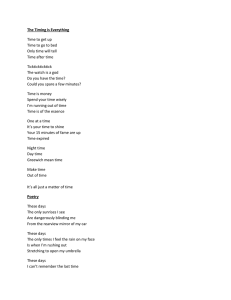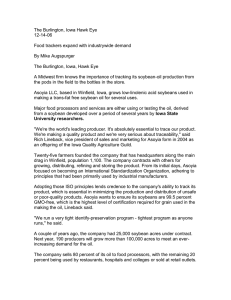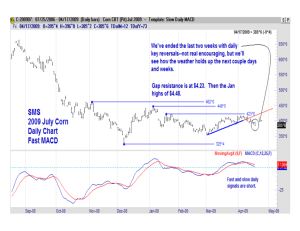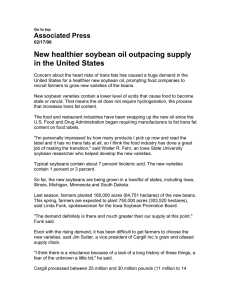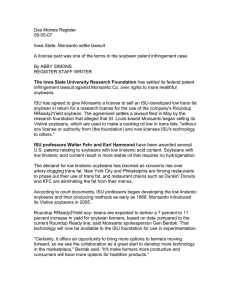Document 13273652
advertisement
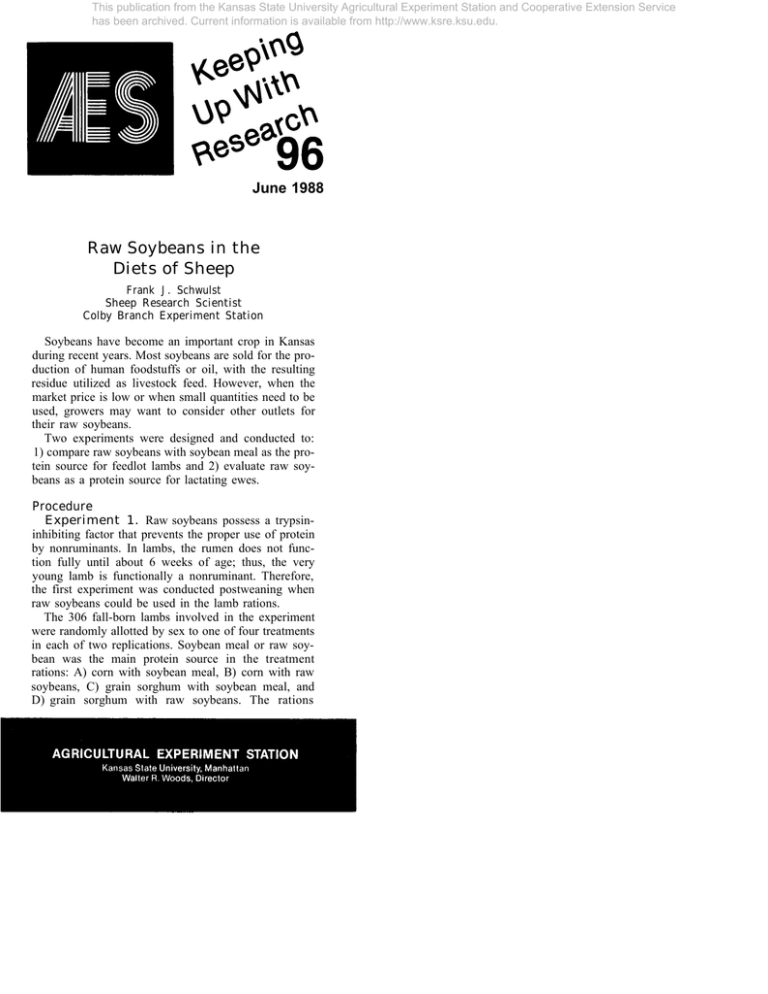
This publication from the Kansas State University Agricultural Experiment Station and Cooperative Extension Service has been archived. Current information is available from http://www.ksre.ksu.edu. June 1988 Raw Soybeans in the Diets of Sheep Frank J. Schwulst Sheep Research Scientist Colby Branch Experiment Station Soybeans have become an important crop in Kansas during recent years. Most soybeans are sold for the production of human foodstuffs or oil, with the resulting residue utilized as livestock feed. However, when the market price is low or when small quantities need to be used, growers may want to consider other outlets for their raw soybeans. Two experiments were designed and conducted to: 1) compare raw soybeans with soybean meal as the protein source for feedlot lambs and 2) evaluate raw soybeans as a protein source for lactating ewes. Procedure Experiment 1. Raw soybeans possess a trypsininhibiting factor that prevents the proper use of protein by nonruminants. In lambs, the rumen does not function fully until about 6 weeks of age; thus, the very young lamb is functionally a nonruminant. Therefore, the first experiment was conducted postweaning when raw soybeans could be used in the lamb rations. The 306 fall-born lambs involved in the experiment were randomly allotted by sex to one of four treatments in each of two replications. Soybean meal or raw soybean was the main protein source in the treatment rations: A) corn with soybean meal, B) corn with raw soybeans, C) grain sorghum with soybean meal, and D) grain sorghum with raw soybeans. The rations This publication from the Kansas State University Agricultural Experiment Station and Cooperative Extension Service has been archived. Current information is available from http://www.ksre.ksu.edu. Table 1. Ration Composition, Experiment I Ingredient A Alfalfa Corn Grain Sorghum SBM Soybeans Limestone Salt 15 69 — 13 — 2 1 Treatments B C -%15 15 62 — 75 7 20 — 2 2 1 1 D 15 70 — 12 2 1 Added to all rations: Vit. A (1,000 IU)/lb. of feed; Vit. D (400 IU)/lb. of feed; and Terramycin .10 reg./lb. of feed. Table 2. Daily Rations, Experiment II Ingredient Corn silage Alfalfa Grain Sorghum Soybeans A 8.0 1.0 1.5 — Treatments B C -lbs8.0 8.0 – – 1.0 1.5 1.0 0.5 D 8.0 0.5 1.0 0.5 (Table 1) were ground and mixed in a portable hammermill mixer and were fed, ad libitum, in hog feeders. Ewes with lambs about 1 week old entered the treatment lots once a week over a period of several weeks. Weaning, which occurred at 50 + 3 days, also required several weeks to complete. When weaned, lambs remained in their original lot, and ewes were removed. Prior to weaning the youngest lambs, all rations contained soybean meal but no raw soybeans. Raw soybeans were introduced to treatments B and D after all lambs in each group had been weaned. Consequently, some lambs continued on soybean meal for a week or two after weaning. Experiment II. The second experiment was designed to evaluate raw soybeans as the primary protein source for lactating ewes. Soybeans replaced all or a portion of the alfalfa and grain components of the lactation diets. The daily rations (Table 2) were weighed to the nearest tenth of a pound and fed by hand. The entire ration was consumed daily, with the exception of the coarsest stalks and stems. The soybeans and grain sorghum were fed whole, and the alfalfa was tubground. Composition of the daily intake is presented in Table 3. The This publication from the Kansas State University Agricultural Experiment Station and Cooperative Extension Service has been archived. Current information is available from http://www.ksre.ksu.edu. Table 3. Composition of Daily Intake, Experiment II Ingredient Dry matter Crude protein TDN A 4.61 0.49 3.29 Treatments B C -lbs4.20 4.17 0.68 0.53 3.27 3.20 D 4.19 0.56 3.10 diets that included soybeans were generally higher in crude protein but lower in dry matter and TDN content. Ewes and lambs were randomly assigned to treatment groups when the lambs were 5-7 days old. Ewes remained on the experimental diets until their lambs were weaned at 50 + 3 days. Lambs in all treatment groups had access to identical creep diets. The ground creep ration was composed of grain sorghum, alfalfa, and soybean meal. Results and Discussion Experiment I. Lambs fed the corn and soybean meal ration (A) were 6.9 pounds heavier when marketed than those fed the ration of corn and soybeans (B). The reverse was true with the grain sorghum rations: lambs fed the ration containing soybeans (D) were 3.1 pounds heavier than were those on the soybean meal ration (C); however, the difference was not significant. Performance data are presented in Table 4. The average daily gain of treatment A lambs was significantly (P < .05) greater than the average gain of lambs on each of the other treatments. Daily gains ranged from .776 pound with treatment A (corn and soybean meal) to .674 pound for the treatment B group (corn and soybeans). Lambs on grain sorghum rations with either soybeans or soybean meal showed intermediate gains of slightly more than .7 pound per day. It should be noted that gains by lambs on all rations were at levels very acceptable in most production systems. Feed efficiency data showed a wide range among treatments. Rations containing raw soybeans were both the most efficient (B) and the least efficient (D), depending upon the associated grain. The corn and soybeans combination (B) required 4.09 pounds of feed per pound of gain compared with 5.12 pounds of the grain sorghum and soybeans ration (D). Although the data collected in this experiment cannot verify an explanation, it is possible that the corn and soybeans ration This publication from the Kansas State University Agricultural Experiment Station and Cooperative Extension Service has been archived. Current information is available from http://www.ksre.ksu.edu. Table 4. Performance Data, Experiment I Item No. lambs Initial wt. (lb.) Avg. final wt. (lb.) ADG (lb.) Feed/lb. grain (lb.) Treatments B C D 76 75 78 77 41.4 40.9 40.8 38.7bc a b 1 0 7 . 2 l00.3 l02.0 1 0 5 . 1 ac b b 0.78 a 0.67 b 0.71 0.72 4.33 4.09 4.83 5.12 A abc = values on the same line with different superscripts differ significantly (P < .05) Table 5. Lamb Performance, Experiment II Item No. lambs Birth weight (lb.) Weaning weight (lb.) ADG (lb.) Weaning age (days) A 34 11.8 44.8 0.65 50.9 Treatments B C 32 36 11.6 11.8 42.9 43.6 0.62 0.63 50.6 50.5 D 35 12.1 44.4 0.65 49.9 contained enough fat to suppress intake and subsequently reduce gain. However, the average daily gain (.674 pound) attained by lambs on that ration would be acceptable under most management systems. Experiment II. Performance of ewes was evaluated in terms of their lambs’ preweaning growth rate. The performance data (Table 5) show that there were no significant differences among treatments in weaning weight or average daily gain. Actual weaning weights and preweaning average daily gains for lambs on all treatments were higher than averages for the general station flock. Lambs in the second experiment had access to the feed bunks containing the ewe diets with raw soybeans. As weaning age neared, the lambs frequently were seen eating the ewe feed. Although they probably ate considerable amounts of that feed, there was never any indication of problems caused by consumption of raw soybeans. When very young lambs began eating ewe feed, they probably nibbled mainly on the finer portion of the ration. As the lambs approached weaning age and were more likely to consume whole soybeans, they may have been old enough to have functional rumens, reducing the probability of digestive problems. This publication from the Kansas State University Agricultural Experiment Station and Cooperative Extension Service has been archived. Current information is available from http://www.ksre.ksu.edu. Summary This study indicated that raw soybeans can successfully replace soybean meal as the protein source in the diet of feedlot lambs. Feeding 20% raw soybeans in a corn-based ration resulted in a slower but still acceptable rate of gain, when compared with a corn-based ration containing soybean meal. There was no significant difference in gains of lambs fed grain sorghum rations containing soybean meal or raw soybeans. Raw soybeans replaced all of the alfalfa and up to a third of the grain in the diets of lactating ewes without effect on the weaning weights and average daily gain of their lambs. This publication from the Kansas State University Agricultural Experiment Station and Cooperative Extension Service has been archived. Current information is available from http://www.ksre.ksu.edu. Contribution No. 88-311-S from the KAES Agricultural Experiment Station, Manhattan 66506 Keeping Up With Research 96 June 1988 Publications and public meetings by the Kansas Agricultural Experiment Station are available and open to the public regardless of race, color, national origin, sex, or handicap. 6-88—3M

